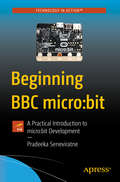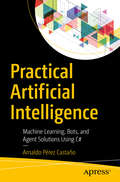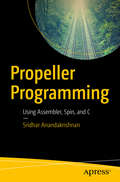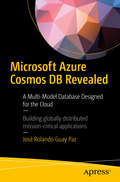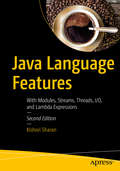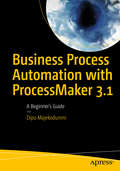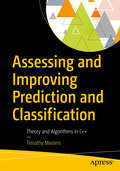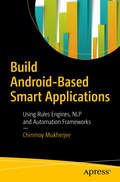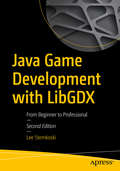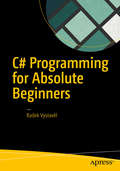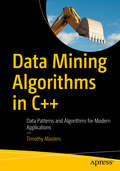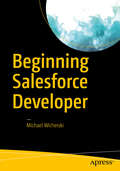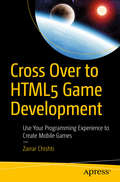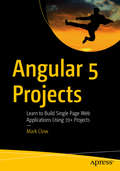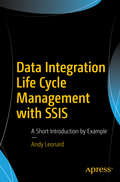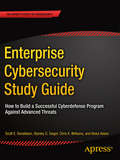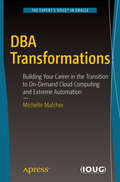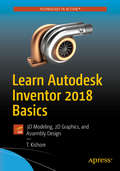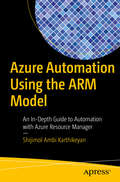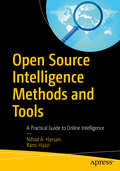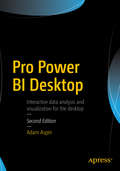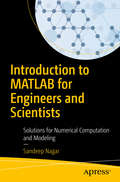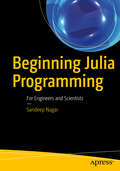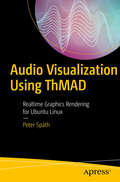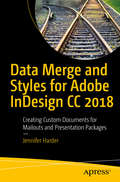- Table View
- List View
Beginning BBC micro:bit
by Pradeeka SeneviratneLearn essential concepts and techniques to build simple-to-advanced projects and overcome common programming challenges in micro:bit development. Beginning BBC micro:bit will take you through the complete features and capabilities of the micro:bit controller, enabling you to program and build your own projects. The uses are endless for the micro:bit and this books will help get you started on building your next project with this popular and easy-to-use microcontroller. You'll use online Python Editor and Mu Editor to build your own applications. Reviewed by the micro:bit developer team, this comprehensive guide also provides clean code examples to help you learn the key concepts behind the micro:bit API. What You’ll LearnWork with the various kits and accessoriesMaster the micro:bit development platform with easy to follow examples and clean codeBuild your own micro:bit applications using an online Python editor and Mu editorUse the on-board LED matrix, built-in buttons, I/O pins, accelerometer, and compassLearn how to connect and communicate with devices through I2C, SPI, and UARTBuild applications with music and speech librariesUse Local Persistent File System to store and manipulate filesBuild applications based on wired and radio networksUse micro:bit and micro:bit Blue appsWho This Book Is ForBeginners, those already experienced with electronics, and hobbyists at all levels looking to get started with a new microcontroller.
Practical Artificial Intelligence: Machine Learning, Bots, and Agent Solutions Using C#
by Arnaldo Pérez CastañoDiscover how all levels Artificial Intelligence (AI) can be present in the most unimaginable scenarios of ordinary lives. This book explores subjects such as neural networks, agents, multi agent systems, supervised learning, and unsupervised learning. These and other topics will be addressed with real world examples, so you can learn fundamental concepts with AI solutions and apply them to your own projects.People tend to talk about AI as something mystical and unrelated to their ordinary life. Practical Artificial Intelligence provides simple explanations and hands on instructions. Rather than focusing on theory and overly scientific language, this book will enable practitioners of all levels to not only learn about AI but implement its practical uses.What You’ll LearnUnderstand agents and multi agents and how they are incorporatedRelate machine learning to real-world problems and see what it means to youApply supervised and unsupervised learning techniques and methods in the real worldImplement reinforcement learning, game programming, simulation, and neural networksWho This Book Is ForComputer science students, professionals, and hobbyists interested in AI and its applications.
Propeller Programming: Using Assembler, Spin, And C
by Sridhar AnandakrishnanLearn to program the Propeller in Spin and C and how to map the Propeller Assembler (PASM) language from other high-level languages you might know.The overall task you will pursue in the book is to implement a Delta Compression algorithm: first in Spin, then in PASM, then in C. Along the way, you'll review test driven development, a powerful technique for validating code, and conclude with a chapter on hardware manipulations. The book's main goal is to help you extend the capabilities of the Propeller processor by using the assembler language.What You’ll LearnUse a data compression/decompression application to introduce PASM to the readerIntegrate C and PASM codeReview hardware interactions (setting and reading pins)Who This Book Is ForThose who are familiar with Spin programming for the Parallax Propeller but have an interest in learning Propeller C and Propeller Assembler (PASM) programming. Some knowledge of C or Python is also helpful.
Microsoft Azure Cosmos DB Revealed: A Multi-Model Database Designed for the Cloud
by José Rolando Guay PazLearn the main features of Azure Cosmos DB and how to use Microsoft’s multi-model database service as a data store for mission-critical applications. The clear examples help in writing your own applications to take advantage of Cosmos DB’s multi-model, globally distributed, elastic database. Simple step-by-step instructions show how to resolve common and uncommon scenarios involving Azure Cosmos DB, and scenarios such as delivering extremely low response times (in the order of milliseconds), and scaling rapidly and globally.Microsoft Azure Cosmos DB Revealed demonstrates a multitude of possible implementations to get you started. This book guides you toward best practices to get the most out of Microsoft’s Cosmos DB service. Later chapters in the book cover advanced implementation features, helping you master important elements such as securing the database, querying, and using various APIs. What You'll LearnSet up a development environment to work with Azure Cosmos DBConfigure Azure Cosmos DB in a production environment with multi-region distributionQuery using all APIs, including SQL, JavaScript, MongoDB, and GraphWork with the Azure Cosmos DB.NET SDK in an application you builtAccess Cosmos DB from web applications created in .NETWho This Book Is ForDevelopers who build applications to be hosted in Microsoft Azure, whether they use PaaS or IaaS. No previous knowledge of Azure Cosmos DB is assumed, but readers must be familiar with developing applications in Microsoft Visual Studio.
Java Language Features: Lambda Expressions, Inner Classes, Threads, I/o And Collections
by Kishori SharanWork with essential and advanced features of the Java programming language such as Java modules development, lambda expressions (closures), inner classes, threads, I/O, Collections, garbage collection, and more. Author Kishori Sharan provides over 50 diagrams and 290 complete programs to help you visualize and better understand the topics covered in this book.Java Language Features, Second Edition starts with a series of chapters on the essential language features provided by Java, including annotations, reflection, and generics. These topics are then complemented by details of how to use lambda expressions, allowing you to build powerful and efficient Java programs. The chapter on threads follows this up and discusses everything from the very basic concepts of a thread to the most advanced topics such as synchronizers, the fork/join framework, and atomic variables.This book contains unmatched coverage of Java NIO, the Stream API, the Path API, the FileVisitor API, the watch service, and asynchronous file I/O. With this in-depth knowledge, your data- and file-management programs will be able to take advantage of every feature of Java's powerful I/O framework and much more.Additionally, three appendices are available for free via the Download Source Code on apress.com. These appendices will give you a head start on the most important features of Java 10 and the new Java versioning scheme.What You’ll LearnUse essential and advanced features of the Java languageCode Java annotations and inner classesWork with reflection, generics, and threadsTake advantage of the garbage collectorManage streams with the Stream APIWho This Book Is ForThose new to Java programming and continues the learning Java journey; it is recommended that you read an introductory Java programming book first, such as Beginning Java Fundamentals, from Apress.
Business Process Automation with ProcessMaker 3.1: A Beginner’s Guide
by Dipo MajekodunmiUse this practical, hands-on guide to get started with ProcessMaker. The book provides clear steps for you to walk through and set up ProcessMaker on your own system and make processes run faster and smarter. You will model and build a complete business process for requesting, approving, and reporting expenses. In the course of building the process, you will understand: The Workflow Designer for modeling business processes using BPMN 2. 0 The Dynaform Designer for creating responsive HTML forms Input and Output documents for capturing supporting documents for business processes and generating standardized documents from the data captured in a process Triggers for implementing custom business logic and extending ProcessMaker functionality What You'll Learn Send email notifications and add comments to cases Build complex routing rules Manage users and their permissions Deploy ProcessMaker to a cloud server Configure and use the ProcessMaker mobile app Who This Book Is For Business analysts, programmers, and professionals in all industries (e. g. , higher education, finance and insurance, government, healthcare, manufacturing, and telecommunications)
Assessing and Improving Prediction and Classification: Theory and Algorithms in C++
by Timothy MastersThis book begins by presenting methods for performing practical, real-life assessment of the performance of prediction and classification models. It then goes on to discuss techniques for improving the performance of such models by intelligent resampling of training/testing data, combining multiple models into sophisticated committees, and making use of exogenous information to dynamically choose modeling methodologies. Rigorous statistical techniques for computing confidence in predictions and decisions receive extensive treatment. Finally, a hundred pages are devoted to the use of information theory in evaluating and selecting useful predictors. Special attention is paid to Schreiber's Information Transfer, a recent generalization of Grainger Causality. Well commented C++ code is given for every algorithm and technique. The ultimate purpose of this text is three-fold. The first goal is to open the eyes of serious developers to some of the hidden pitfalls that lurk in the model development process. The second is to provide broad exposure for some of the most powerful model enhancement algorithms that have emerged from academia in the last two decades, while not bogging down readers in cryptic mathematical theory. Finally, this text should provide the reader with a toolbox of ready-to-use C++ code that can be easily incorporated into his or her existing programs.
Build Android-Based Smart Applications: Using Rules Engines, NLP and Automation Frameworks
by Chinmoy MukherjeeBuild smart applications using cutting-edge technologies such as rules engines, code automation frameworks, and natural language processing (NLP). This book provides step-by-step instructions on how to port nine rules engines (CLIPS, JRuleEngine, DTRules, Zilonis, TermWare, Roolie, OpenRules, JxBRE, and JEOPS) to the Android platform. You'll learn how to use each rules engine to build a smart application with sample code snippets so that you can get started with programming smart applications immediately. Build Android-Based Smart Applications also describes porting issues with other popular rules engines (Drools, JLisa, Take, and Jess). This book is a step-by-step guide on how to generate a working smart application from requirement specifications. It concludes by showing you how to generate a smart application from unstructured knowledge using the Stanford POS (Part of Speech) tagger NLP framework. What You Will Learn Evaluate the available rules engines to see which rules engine is best to use for building smart applications Build smart applications using rules engines Create a smart application using NLP Automatically generate smart application from requirement specifications Who This Book Is For Android and web developers with some experience.
Java Game Development with LibGDX
by Lee StemkoskiDesign and create video games using Java, with the LibGDX software library. By reading Beginning Java Game Development with LibGDX, you will learn how to design video game programs and how to build them in Java. You will be able to create your own 2D games, using various hardware for input (keyboard/mouse, gamepad controllers, or touchscreen), and create executable versions of your games. The LibGDX library facilitates the game development process by providing pre-built functionality for common tasks. It is a free, open source library that includes full cross-platform compatibility, so programs written using this library can be compiled to run on desktop computers (Windows/MacOS), web browsers, and smartphones/tablets (both Android and iOS). Beginning Java Game Development with LibGDX teaches by example with many game case study projects that you will build throughout the book. This ensures that you will see all of the APIs that are encountered in the book in action and learn to incorporate them into your own projects. The book also focuses on teaching core Java programming concepts and applying them to game development. What You Will Learn How to use the LibGDX framework to create a host of 2D arcade game case studies How to compile your game to run on multiple platforms, such as iOS, Android, Windows, and MacOS How to incorporate different control schemes, such as touchscreen, gamepad, and keyboard Who This Book Is For Readers should have an introductory level knowledge of basic Java programming. In particular, you should be familiar with: variables, conditional statements, loops, and be able to write methods and classes to accomplish simple tasks. This background is equivalent to having taken a first-semester college course in Java programming.
C# Programming for Absolute Beginners
by Radek VystavělGet started using the C# programming language. Based on the author’s 15 years of experience teaching beginners, the book provides you with a step-by-step introduction to the principles of programming, or rather, how to think like a programmer. The task-solution approach will get you immersed, with minimum theory and maximum action.What You Will LearnUnderstand what programming is all aboutWrite simple, but non-trivial, programsBecome familiar with basic programming constructs such as statements, types, variables, conditions, and loopsLearn to think like a programmer and combine these programming constructs in new waysGet to know C# as a modern, mainstream programming language, and Visual Studio as one of the world’s most popular programming toolsWho This Book Is ForThose with very little or no experience in computer programming, who know how to use a computer, install a program, and navigate the web.
Data Mining Algorithms in C++: Data Patterns and Algorithms for Modern Applications
by Timothy MastersIn my decades of custom programming and consultation, I have explored diverse applications, including automated analysis of high-altitude photographs, automated medical diagnosis, realtime detection of threatening military vehicles, and automated trading of financial markets. A common thread in all of these applications is that I was faced with a multitude of observed or computed variables, and my task involved finding and analyzing relationships among these variables. As a result, I have accumulated a wealth of algorithms for doing so. This book presents theoretical and intuitive justifications, along with highly commented source code, for my favorite data-mining techniques. This book makes no pretense of being 'complete' in any manner whatsoever. Please do not be annoyed if your own favorite techniques did not make my cut, or if the book ignores some popular standard techniques. These are simply the algorithms that I have found most useful in my own work over the years. Some of them are venerable old techniques such as the use of maximum-likelihood factor analysis for determining the degree to which variables contain unique information, versus being redundant due to hidden common factors impacting several variables. Some of them are powerful modern techniques, such as Combinatorially Symmetric Cross Validation for determining if a model is hampered by overfitting, or Feature Weighting as Regularized Energy-Based Learning for ranking variables in predictive power when there are too few training cases to employ traditional methods. Some of them are (I believe) my own invention, such as a method for clustering variables in the restricted context of a subspace of interest, and visual display of anomalous regions in which joint and marginal densities conflict, or in which contribution to mutual information is concentrated. But all of them share a great quality: I have found them to be exceptionally useful in my own data-mining endeavors. I suspect that you will as well.
Beginning Salesforce Developer
by Michael WicherskiGet started developing on the Force. com platform in no time. With step-by-step guidance, starting with setting up your developer environment and progressing through to deploying to production, you will learn industry best practices to release robust custom applications with tangible benefits to your company or your client. Geared specifically toward beginning developers, Beginning Salesforce Developer establishes a strong understanding of basic code constructs through examples. Rather than simply explaining how to use the platform, you will receive a comprehensive understanding of why, allowing you to address platform quirks and "gotchas" that might occur. The book also serves to lay the foundation for continuing on to Salesforce Developer Pro. What You'll Learn Configure your Salesforce development environment Understand the Salesforce data model and query languages Create basic Apex triggers Use standard controllers with basic Visualforce pages Utilize Visualforce with custom-built Apex controllers Write test coverage Who This Book Is For Salesforce administrators who wish to transition into developing on the Force. com platform. The book also serves as a quick immersion into the world of development for complete beginners through proprietary Salesforce development languages on the Force. com platform.
Cross Over to HTML5 Game Development: Use Your Programming Experience to Create Mobile Games
by Zarrar ChishtiBreak into the most lucrative platform in the world by adding HTML5 game development to your current skillset. Zarrar Chishti has trained developers from a wide range of programming disciplines to cross over into HTML5 game development. Whatever your vocation, whether it be an Application Databases Systems developer or a Professional Web developer, with this book you will learn to evolve your current coding skills to become eligible for the biggest gaming platform in the world. From the first chapter you will see encouraging results immediately as you power through a challenging and fun project that has been uniquely designed and developed for this book. With the relentless backing of the giants of the industry including Apple and Google, HTML5 is rapidly becoming the leading technology for game development. Furthermore nearly every mobile device, tablet and PC system offer full support to the latest games developed in HTML5. Never before has there been such a widely accepted platform by literally every manufacturer and operating system. This in turn has convinced marketing departments to move away from traditional platforms, such as dedicated mobile apps, for the more widely accepted HTML5 format. There has never been a better time for a seasoned IT programmer to crossover and capitalize in this lucrative market with their much sought after talents and experience. Take the skills you already have and expand your career into HTML5 development with this book. What You'll Learn Quickly identify the core similarities and differences between HTML5 and other coding standards Follow a large scale game development project to experience the full lifecycle of an HTML5 game development project Download graphics and media to use in sample projects throughout the book Who This Book Is For Professional developers working in application and database development. These seasoned coders, having secured a wealth of knowledge, can transfer that expertise to the growing HTML5 game development market. This book will instantly appeal to this audience as it will not attempt to teach the basics of programming; instead it will simply point out the differences in how to develop with HTML5.
Angular 5 Projects: Learn to Build Single Page Web Applications Using 70+ Projects
by Mark ClowLearn to build single page web apps using Angular 5 and TypeScript by working through 70+ mini-projects. With hundreds of code examples you gain a thorough understanding of the Angular 5 ecosystem and how to work within it. <P><P> You'll begin by understanding the benefits of Angular 5 vs older versions, and how this benefits your applications. You'll then move onto mini-projects that teach you JavaScript, TypeScript, how to use editors, Node, CLI, components, modules, directives, Webpack, dependency injection, widgets, routes and navigation, observers, reactive programming, and RxJS. <P> Complete with a consistently-updated online code repository, this book is a great way to get started with Angular 5.
Data Integration Life Cycle Management with SSIS: A Short Introduction By Example
by Andy LeonardBuild a custom BimlExpress framework that generates dozens of SQL Server Integration Services (SSIS) packages in minutes. Use this framework to execute related SSIS packages in a single command. You will learn to configure SSIS catalog projects, manage catalog deployments, and monitor SSIS catalog execution and history. Data Integration Life Cycle Management with SSIS shows you how to bring DevOps benefits to SSIS integration projects. Practices in this book enable faster time to market, higher quality of code, and repeatable automation. Code will be created that is easier to support and maintain. The book teaches you how to more effectively manage SSIS in the enterprise environment by drawing on the art and science of modern DevOps practices. What You'll Learn Generate dozens of SSIS packages in minutes to speed your integration projects Reduce the execution of related groups of SSIS packages to a single command Successfully handle SSIS catalog deployments and their projects Monitor the execution and history of SSIS catalog projects Manage your enterprise data integration life cycle through automated tools and utilities Who This Book Is For Database professionals working with SQL Server Integration Services in enterprise environments. The book is especially useful to those readers following, or wishing to follow, DevOps practices in their use of SSIS.
Enterprise Cybersecurity Study Guide: How To Build A Successful Cyberdefense Program Against Advanced Threats
by Scott E. Donaldson Stanley G. Siegel Chris K. Williams Abdul AslamUse the methodology in this study guide to design, manage, and operate a balanced enterprise cybersecurity program that is pragmatic and realistic in the face of resource constraints and other real-world limitations. This guide is an instructional companion to the book Enterprise Cybersecurity: How to Build a Successful Cyberdefense Program Against Advanced Threats. The study guide will help you understand the book’s ideas and put them to work. The guide can be used for self-study or in the classroom.Enterprise cybersecurity is about implementing a cyberdefense program that will succeed in defending against real-world attacks. While we often know what should be done, the resources to do it often are not sufficient. The reality is that the Cybersecurity Conundrum—what the defenders request, what the frameworks specify, and what the budget allows versus what the attackers exploit—gets in the way of what needs to be done. Cyberattacks in the headlines affecting millions of people show that this conundrum fails more often than we would prefer.Cybersecurity professionals want to implement more than what control frameworks specify, and more than what the budget allows. Ironically, another challenge is that even when defenders get everything that they want, clever attackers are extremely effective at finding and exploiting the gaps in those defenses, regardless of their comprehensiveness. Therefore, the cybersecurity challenge is to spend the available budget on the right protections, so that real-world attacks can be thwarted without breaking the bank.People involved in or interested in successful enterprise cybersecurity can use this study guide to gain insight into a comprehensive framework for coordinating an entire enterprise cyberdefense program.What You’ll Learn Know the methodology of targeted attacks and why they succeed Master the cybersecurity risk management process Understand why cybersecurity capabilities are the foundation of effective cyberdefenses Organize a cybersecurity program's policy, people, budget, technology, and assessment Assess and score a cybersecurity program Report cybersecurity program status against compliance and regulatory frameworks Use the operational processes and supporting information systems of a successful cybersecurity program Create a data-driven and objectively managed cybersecurity program Discover how cybersecurity is evolving and will continue to evolve over the next decade Who This Book Is For Those involved in or interested in successful enterprise cybersecurity (e.g., business professionals, IT professionals, cybersecurity professionals, and students). This guide can be used in a self-study mode. The book can be used by students to facilitate note-taking in the classroom and by Instructors to develop classroom presentations based on the contents of the original book, Enterprise Cybersecurity: How to Build a Successful Cyberdefense Program Against Advanced Threats.
DBA Transformations: Building Your Career in the Transition to On-Demand Cloud Computing and Extreme Automation
by Michelle MalcherAdapt your career as a database administrator to the changing industry. Learn where the growth and demand for DBA talent are occurring and how to enhance your skill set. Creating databases, providing access, and controlling data are no longer the focus. What matters now is managing and monitoring the systems that provide access to users of the data. This book will help you formulate a plan for development and change to remain valuable in the face of radical new developments around cloud computing, containerized databases, and automation of routine tasks. The playing field is shifting rapidly with the development of technologies and software enhancements that automate and even eliminate many traditional aspects of the DBA job. DBA Transformation helps you redirect your attention and skills as a DBA to areas such as design and development of the containers and cloud environments on which automation depends. You will be encouraged to build soft skills as well as to focus on technical pain points such as data security that are of even greater importance now that so much corporate data is in cloud-based systems that are accessible from the Internet at large. What You'll Learn Embrace and profit from rapid shifts in the database industry Recognize where growth and demand for talent are occurring Create a personal transformation plan to help you navigate the changes Pivot your career toward more interesting skills and responsibilities Who This Books Is For Working database professionals who are interested in keeping their careers relevant as well as building their careers and making them stronger in the face of dramatic changes that are being driven by trends toward cloud computing and containerization
Learn Autodesk Inventor 2018 Basics: 3D Modeling, 2D Graphics, and Assembly Design
by T. KishoreGet started with the basics of part modeling, assembly modeling, presentations, and drawings in this step-by-step tutorial on Autodesk Inventor fundamentals. Next, this book teaches you some intermediate-level topics such as additional part modeling tools, sheet metal modeling, top-down assembly features, assembly joints, and dimension and annotations. Engaging explanations, practical examples, and step-by-step instructions make this tutorial book complete. Once you have read Learn Autodesk Inventor 2018 Basics you will be able to use Autodesk Inventor for 3D modeling, 2D drawings, finite element analysis, mold design, and other purposes, just like a design professional. You will gain all the basic information and essential skills you need to work in Autodesk Inventor immediately. What You'll Learn Carry out virtual 3D modeling for your next 3D printing projects Design molds for 3D printing and other projects Generate 2D drawings Who This Book Is For Novice users of Autodesk Inventor.
Azure Automation Using the ARM Model: An In-Depth Guide to Automation with Azure Resource Manager
by Shijimol Ambi KarthikeyanFocus exclusively on the Azure Resource Manager (ARM) deployment model for Azure automation and gain in-depth knowledge of topics such as runbook authoring, different types of automation runbooks, and hybrid cloud automation. This book covers practical approaches to creating runbooks for multiple use cases, including operational tasks such as VM management and integration of Azure automation with infrastructure monitoring solutions, such as Operations Management Suite (OMS). Along the way you'll see how to use PowerShell in Azure automation and cover essentials including Azure automation security, source control integration, and runbook output streams. Finally, you learn about integrating Azure automation with Desired State Configuration (DSC) to include various cloud, on-premise, and hybrid scenarios. What You Will Learn #65533; Work with the building blocks of Azure automation #65533; Create different types of runbook #65533; Master hybrid cloud automation with ARM #65533; Implement cloud automation use cases with practical examples Who This Book Is For Infrastructure and cloud architects, cloud support engineers, and system administrators.
Open Source Intelligence Methods and Tools: A Practical Guide to Online Intelligence
by Nihad A. Hassan Rami HijaziApply Open Source Intelligence (OSINT) techniques, methods, and tools to acquire information from publicly available online sources to support your intelligence analysis. Use the harvested data in different scenarios such as financial, crime, and terrorism investigations as well as performing business competition analysis and acquiring intelligence about individuals and other entities. This book will also improve your skills to acquire information online from both the regular Internet as well as the hidden web through its two sub-layers: the deep web and the dark web.The author includes many OSINT resources that can be used by intelligence agencies as well as by enterprises to monitor trends on a global level, identify risks, and gather competitor intelligence so more effective decisions can be made. You will discover techniques, methods, and tools that are equally used by hackers and penetration testers to gather intelligence about a specific target online. And you will be aware of how OSINT resources can be used in conducting social engineering attacks. Open Source Intelligence Methods and Tools takes a practical approach and lists hundreds of OSINT resources that can be used to gather intelligence from online public sources. The book also covers how to anonymize your digital identity online so you can conduct your searching activities without revealing your identity. What You’ll Learn Identify intelligence needs and leverage a broad range of tools and sources to improve data collection, analysis, and decision making in your organizationUse OSINT resources to protect individuals and enterprises by discovering data that is online, exposed, and sensitive and hide the data before it is revealed by outside attackersGather corporate intelligence about business competitors and predict future market directionsConduct advanced searches to gather intelligence from social media sites such as Facebook and TwitterUnderstand the different layers that make up the Internet and how to search within the invisible web which contains both the deep and the dark webs Who This Book Is For Penetration testers, digital forensics investigators, intelligence services, military, law enforcement, UN agencies, and for-profit/non-profit enterprises
Pro Power BI Desktop
by Adam AspinThis book shows how to deliver eye-catching Business Intelligence with Microsoft Power BI Desktop. You can now take data from virtually any source and use it to produce stunning dashboards and compelling reports that will seize your audience's attention. Slice and dice the data with remarkable ease then add metrics and KPIs to project the insights that create your competitive advantage. Make raw data into clear, accurate, and interactive information with Microsoft's free self-service business intelligence tool. Pro Power BI Desktop will help you to push your BI delivery to the next level. You'll learn to create great-looking visualizations and let your audience have fun by interacting with the elegant and visually arresting output that you can now deliver. You can choose from a wide range of built-in and third-party visualization types so that your message is always enhanced. You'll be able to deliver those results on the PC, on tablets, on smartphones, as well as share results via the cloud. Finally, this book helps you save time by preparing the underlying data correctly without needing an IT department to prepare it for you. Power BI Desktop will let your analyses speak for themselves. Simple techniques to make data into insight. Polished interactive dashboards to deliver attention-grabbing information. Visually arresting output on multiple devices grab the reader's attention. What You Will Learn Produce designer output to astound your bosses and peers. Share business intelligence in the cloud Deliver visually stunning charts, maps, and tables. Make them interactive too! Find new insights as you chop and tweak your data as never before. Adapt delivery to mobile devices such as phones and tablets. Audience Pro Power BI Desktop is written for any user who is comfortable in Microsoft Office. Everyone from CEOs and Business Intelligence developers through to power users and IT managers can use this book to outshine the competition by producing 21st Century business intelligence visualizations and reporting on a variety of devices from a variety of data sources. All of this is possible through leveraging your existing skill set with the same, common Microsoft tools you already use in your daily work.
Introduction to MATLAB for Engineers and Scientists
by Sandeep NagarFamiliarize yourself with MATLAB using this concise, practical tutorial that is focused on writing code to learn concepts. Starting from the basics, this book covers array-based computing, plotting and working with files, numerical computation formalism, and the primary concepts of approximations. Introduction to MATLAB is useful for industry engineers, researchers, and students who are looking for open-source solutions for numerical computation. In this book you will learn by doing, avoiding technical jargon, which makes the concepts easy to learn. First you'll see how to run basic calculations, absorbing technical complexities incrementally as you progress toward advanced topics. Throughout, the language is kept simple to ensure that readers at all levels can grasp the concepts. What You'll Learn Apply sample code to your engineering or science problems Work with MATLAB arrays, functions, and loops Use MATLAB's plotting functions for data visualization Solve numerical computing and computational engineering problems with a MATLAB case study Who This Book Is For Engineers, scientists, researchers, and students who are new to MATLAB. Some prior programming experience would be helpful but not required.
Beginning Julia Programming: For Engineers and Scientists
by Sandeep NagarGet started with Julia for engineering and numerical computing, especially data science, machine learning, and scientific computing applications. This book explains how Julia provides the functionality, ease-of-use and intuitive syntax of R, Python, MATLAB, SAS, or Stata combined with the speed, capacity, and performance of C, C++, or Java. You'll learn the OOP principles required to get you started, then how to do basic mathematics with Julia. Other core functionality of Julia that you'll cover, includes working with complex numbers, rational and irrational numbers, rings, and fields. Beginning Julia Programming takes you beyond these basics to harness Julia's powerful features for mathematical functions in Julia, arrays for matrix operations, plotting, and more. Along the way, you also learn how to manage strings, write functions, work with control flows, and carry out I/O to implement and leverage the mathematics needed for your data science and analysis projects. "Julia walks like Python and runs like C". This phrase explains why Julia is quickly growing as the most favored option for data analytics and numerical computation. After reading and using this book, you'll have the essential knowledge and skills to build your first Julia-based application. What You'll Learn Obtain core skills in Julia Apply Julia in engineering and science applications Work with mathematical functions in Julia Use arrays, strings, functions, control flow, and I/O in Julia Carry out plotting and display basic graphics Who This Book Is For Those who are new to Julia; experienced users may also find this helpful as a reference.
Audio Visualization Using ThMAD
by Peter SpäthLearn how to use Thinking Machine Audio Dreams (ThMAD), a realtime audio visualization engine for Ubuntu Linux. This book bridges the gap between programmers and artists. Both artists and developers with an inclination towards arts will profit from this book since it is a combination of a hands-on tutorial, manual, and reference, with many illustrations that accompany the explanations and tutorials.You'll learn the basics of ThMAD's open source software suite and then start experimenting and building your own rendering pipelines to create audio visualizations. You'll see how to soundly use all ThMAD's GUI functionalities, and all modules are provided in a way that will serve both intellectual curiosity and professional needs. The examples that are used as part of the software, and the tutorials included in the book, will serve as a solid basis for your own experiments.What You'll LearnUse the ThMAD software, all GUI functionalities, and all modulesDevelop your own audio visualization projectsExplore the program operations for ThMAD Artiste and ThMAD Player, including all possible options for controlling program operations.Who This Book Is ForVisual artists with some IT background, or developers with artistic inclinations. Development experience is not required, but surely helpful.
Data Merge and Styles for Adobe InDesign CC 2018: Creating Custom Documents for Mailouts and Presentation Packages
by Jennifer HarderHarness the power of Adobe InDesign's data merge and style panel. Whether you're creating custom mail-outs or other mail-merge needs, familiarize yourself with this powerful InDesign panel in this in-depth, step-by-step guide. This book shows you how to easily create, edit, and print data merged documents that match specific branding and style guidelines. You'll learn how to combine MS Excel to create a faster workflow and quickly turn your Adobe InDesign CC 2017 files into printer-ready files. In this book, we'll also take a look at how to apply paragraph and character styles to your text and how you can alter formatting using Global Regular Expressions Print (GREPs). With Data Merge and Styles for Adobe InDesign CC 2017 as your guide, you'll see how to save time and money by learning all the peculiarities and powerful features of Adobe InDesign data merge. By the end of this book, you'll be able to streamline your workflow and avoid using MS Word's mail merge and back-and-forth edits. What You'll Learn Create custom print media with text styles using Adobe InDesign CC 2017 Work with GREPs in conjunction with Character and Paragraph Styles to customize data Build a numbering sequence for tickets Create single and multiple data merges Who This Book Is For Students, graphic designers, and corporate administrators who need to create documents for events.
